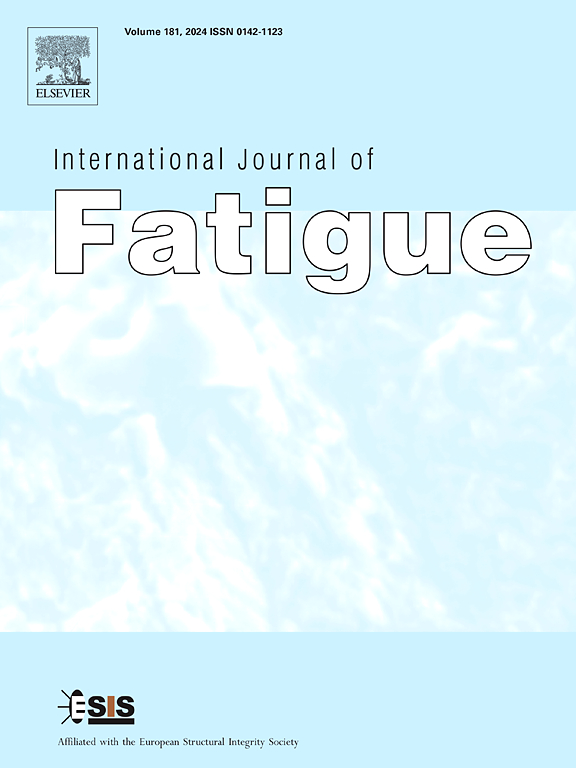基于相场法的高强钢丝腐蚀疲劳点裂转变研究
IF 5.7
2区 材料科学
Q1 ENGINEERING, MECHANICAL
引用次数: 0
摘要
本研究建立了一个耦合腐蚀-疲劳相场模型,通过在统一的计算框架内集成化学-电化学过程和循环加载效应来研究高强度钢丝的点蚀-裂纹转变。通过耦合腐蚀-疲劳试验确定了高强钢丝的腐蚀-疲劳寿命(CFL),相场模型复制了观察到的CFL趋势,证明了其预测材料退化的准确性和可靠性。该模型有效地捕捉了从坑形核到裂纹扩展的整个演化过程。模拟结果表明,坑的几何形状在从腐蚀驱动的退化到机械主导的裂纹扩展的转变中起着关键作用,越窄的坑产生更高的应力集中,从而加速裂纹的形成。此外,界面动力学系数显著影响坑演化和裂纹成核,强调其在腐蚀疲劳损伤过程中的重要性。该研究还确定了临界能量释放率(Gc)是控制点蚀到疲劳裂纹扩展转变的关键力学参数,为评估损伤演变提供了定量标准。所提出的相场模型为预测高强度钢丝的结构退化提供了全面的工具,并为腐蚀疲劳机制提供了基本的见解。本文章由计算机程序翻译,如有差异,请以英文原文为准。
Investigation of the pitting-to-crack transition in corrosion-fatigue of high-strength steel wires based on the phase-field method
This study develops a coupled corrosion-fatigue phase-field model to investigate the pitting-to-crack transition in high-strength steel wires by integrating chemical–electrochemical processes and cyclic loading effects within a unified computational framework. The corrosion-fatigue life (CFL) of high-strength steel wires was determined through coupled corrosion-fatigue experiments, and the phase-field model replicated the observed CFL trends, demonstrating its accuracy and reliability in predicting material degradation. The model effectively captures the entire evolution from pit nucleation to crack propagation. Simulation results show that pit geometry plays a critical role in the transition from corrosion-driven degradation to mechanically dominated crack propagation, with narrower pits generating higher stress concentrations that accelerate crack initiation. Additionally, the interfacial kinetic coefficient significantly influences pit evolution and crack nucleation, underscoring its importance in the progression of corrosion-fatigue damage. The study also identifies the critical energy release rate () as a key mechanical parameter that governs the transition from pitting to fatigue crack growth, providing a quantitative criterion for assessing damage evolution. The proposed phase-field model offers a comprehensive tool for predicting structural degradation in high-strength steel wires and provides fundamental insights into corrosion-fatigue mechanisms.
求助全文
通过发布文献求助,成功后即可免费获取论文全文。
去求助
来源期刊

International Journal of Fatigue
工程技术-材料科学:综合
CiteScore
10.70
自引率
21.70%
发文量
619
审稿时长
58 days
期刊介绍:
Typical subjects discussed in International Journal of Fatigue address:
Novel fatigue testing and characterization methods (new kinds of fatigue tests, critical evaluation of existing methods, in situ measurement of fatigue degradation, non-contact field measurements)
Multiaxial fatigue and complex loading effects of materials and structures, exploring state-of-the-art concepts in degradation under cyclic loading
Fatigue in the very high cycle regime, including failure mode transitions from surface to subsurface, effects of surface treatment, processing, and loading conditions
Modeling (including degradation processes and related driving forces, multiscale/multi-resolution methods, computational hierarchical and concurrent methods for coupled component and material responses, novel methods for notch root analysis, fracture mechanics, damage mechanics, crack growth kinetics, life prediction and durability, and prediction of stochastic fatigue behavior reflecting microstructure and service conditions)
Models for early stages of fatigue crack formation and growth that explicitly consider microstructure and relevant materials science aspects
Understanding the influence or manufacturing and processing route on fatigue degradation, and embedding this understanding in more predictive schemes for mitigation and design against fatigue
Prognosis and damage state awareness (including sensors, monitoring, methodology, interactive control, accelerated methods, data interpretation)
Applications of technologies associated with fatigue and their implications for structural integrity and reliability. This includes issues related to design, operation and maintenance, i.e., life cycle engineering
Smart materials and structures that can sense and mitigate fatigue degradation
Fatigue of devices and structures at small scales, including effects of process route and surfaces/interfaces.
 求助内容:
求助内容: 应助结果提醒方式:
应助结果提醒方式:


